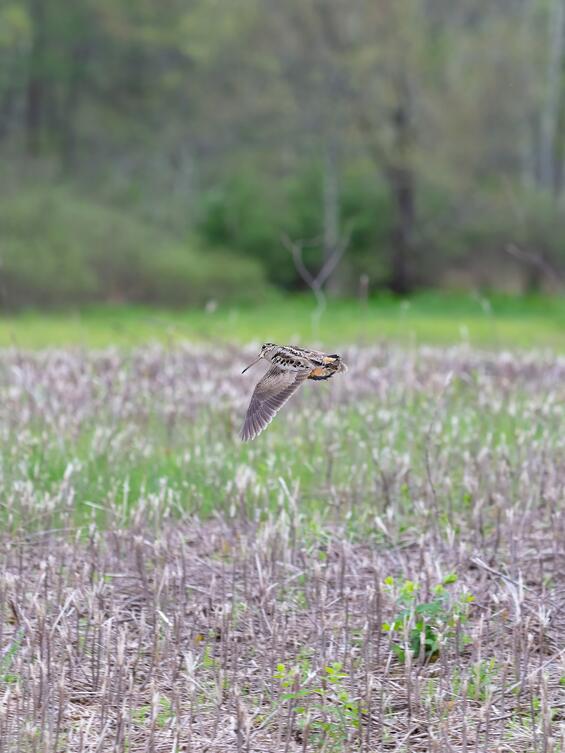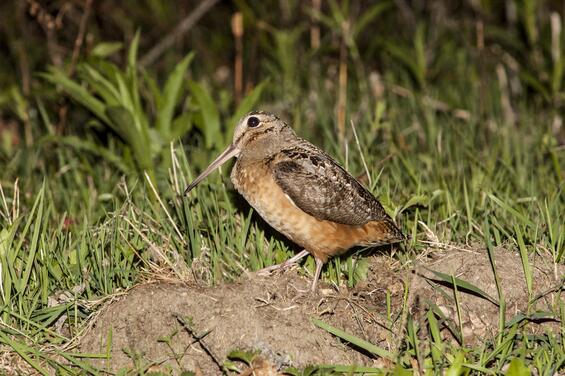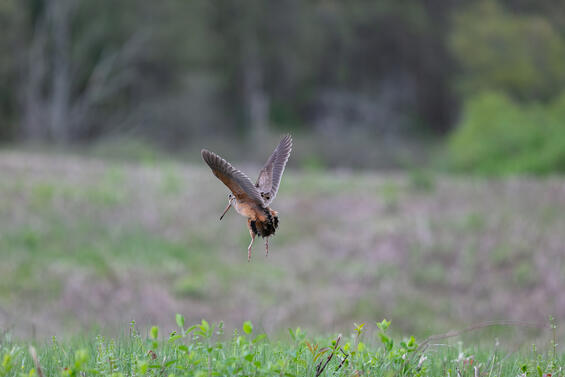- Scientific name: Scolopax minor
- Species of Greatest Conservation Need (MA State Wildlife Action Plan)
Description

The American woodcock is a distinct, compact bird weighing between 116–219 g (4–8 oz). On average, females are larger than males. Males and females are similar in appearance. The plumage is mottled with brown, buff, and gray to camouflage against the forest floor. A long bill measuring 5.9–7.8 cm (2.3–3.07 in) is used to probe the ground for earthworms. The head has three dark transverse bars on the crown and large eyes that are located toward the back of the head.
Life cycle and behavior

This graphic represents the peak timing of life events for American woodcock in Massachusetts. Variation may occur across individuals and their range.
American woodcock are migratory birds. They travel to their winter grounds in the southeastern U.S. in the fall and migrate back to northern North America, include Massachusetts, for their breeding grounds in the spring.
In the spring, migrating woodcock typically arrive in Massachusetts in late February through March. Migrating males will begin their courtship displays upon arriving. From there, some will continue a northward migration while others will remain in Massachusetts and continue courting into late May or early June. American woodcock perform a unique courtship display on most evenings around sunset (sometimes at dawn) that involves the male strutting and walking while “peenting” on the ground, followed by an elaborate aerial display. The male will repeat this process upwards to 20 times a day. Nesting season primarily occurs from mid-April–June with most nests hatching in May or early June. Woodcock nests are located on the ground in a shallow depression lined with leaves made by the female. The female lays 3–4 eggs and will incubate them for 20–22 days. The chicks are highly mobile after hatching and quickly learn to forage. Chicks fledge within 2–3 weeks. In the fall, woodcock begin their southern migration, typically in late October into November, but the timing and degree of migration may be affected by local and regional weather and climate patterns. In warmer years, woodcock can be found mid-winter in areas of Cape Cod and the Islands.
Population status

American woodcock (Scolopax minor)
Monitoring of woodcock through the U.S. Fish and Wildlife Service’s Singing Ground Survey have indicated long-term population declines since the mid-1960’s. However, over the past 10 years the woodcock population index indicated a stable population. These trends are mirrored through the Eastern Management Unit (Virginia through southern Quebec/New Brunswick and Nova Scotia). Woodcock are found across Massachusetts but it’s possible that in more developed areas, woodcock suffer high rates of predation from meso-predators and domestic cats. The long-term decline of woodcock is a result of large-scale changes in land use and composition. In the mid-1950s there were substantial areas of young forest and agricultural lands that provided optimal habitat for game birds in a period with relatively few avian and mammalian predators. Over time, forest maturation, development, and fragmentation has reduced the amount of available habitat and woodcock predator numbers have increased dramatically.
Distribution and abundance
The American woodcock is found throughout the state from early spring through fall. They breed in all counties of Massachusetts. The abundance of woodcock in Massachusetts has changed greatly over time as a result of widespread changes in land use. Woodcock typically arrive in Massachusetts by mid-March. They begin their fall migration south from Canada in late September and travel through Massachusetts during mid-October to mid-November. Woodcock from Massachusetts typically winter in the southeastern United States on the Atlantic and Gulf coastal plains.

Habitat
A mix of old abandoned farms, fields, orchards, and reverting young forest generally provide optimum habitat for American woodcock. Singing grounds and roost sites are characteristically located in larger forest openings (about 5 acres), old pastures, brushy fields, or bogs. Nests are generally found close by in dry young forest woodlands or brushy cover. Daytime feeding habitat includes areas with poorly drained soils, such as alder swales near old fields, or second-growth hardwoods mixed with aspen, birch and alder, with rich, moist soils near ponds, streams, or wet areas. More importantly, these habitats must exist in relative close proximity for optimal reproductive success and survival. Ideally, these habitats are immediately adjacent.
Healthy habitats are vital for supporting native wildlife and plants. Explore habitats and learn about conservation and restoration in Massachusetts.
Threats
American woodcock populations have been declining due to loss of suitable habitat to forest succession and development. Encouraging small clear cuts during timber operations and maintaining early successional areas adjacent to wetlands is the best approach to maintaining and potentially increasing woodcock populations statewide. Most current timber harvesting operations in Massachusetts are of low intensity and subsequently do not create suitable early successional habitat for woodcock and other associated species. Population numbers can be seriously impacted by severe storms and other climatic events during migration and nesting periods. Predation also affects woodcock, particularly in marginal habitats that are impacted by development where meso-predator density (e.g., domestic cats, skunk, raccoon, opossum, fisher) is artificially elevated. Consequently, woodcock in these environments may represent sink populations.
An additional threat to the species is collisions with buildings and other structures, as approximately 1 billion birds in the United States are estimated to die annually from building collisions. A high percentage of these collisions occur during the migratory periods when birds fly long distances between their wintering and breeding grounds. Light pollution exacerbates this threat for nocturnal migrants as it can disrupt their navigational capabilities and lure them into urban areas, increasing the risk of collisions or exhaustion from circling lit structures or areas.
Predation by domestic cats has been identified as the largest source of mortality for wild birds in the United States with the number of estimated mortalities exceeding 2 billion annually. Cats are especially a threat to those species that nest on or near the ground.
Conservation
American woodcocks are surveyed annually from late April to early May as part of the U.S. Fish and Wildlife Service’s Singing Ground Survey. Since 1964, MassWildlife biologists have conducted road-side surveys each spring in the evening to record the number of peenting woodcock heard. Survey routes are randomly located across the state and approximately 20 survey routes are completed each year.
MassWildlife is active in managing a variety of early successional and young forest habitats that are required by woodcock at various times of the year, including open areas for courtship displays in the spring, young and successional forests used for nesting, and shrubby wet areas that are the primary foraging habitat. MassWildlife collaborates with private landowners to manage habitat through partnerships and programs within the U.S. Department of Agriculture (USDA) Farm Bill. MassWildlife also consults and promotes early successional and young forest management beneficial to woodcock and numerous other species with other conservation organizations and public landowners across the state.
Recent research has illustrated migration timing and movements of woodcock in the Eastern Management Unit. This was very important to understand potential changes in migration patterns and timing that may be related to climate change. This information is useful to harvest mangers to optimally schedule woodcock hunting seasons and habitat management practitioners to identify seasonally important habitats.
Bird collision mortalities can be minimized by making glass more visible to birds. This includes using bird-safe glass in new construction and retrofitting existing glass (e.g., screens, window decals) to make it bird-friendly and reducing artificial lighting around buildings (e.g., Lights Out Programs, utilizing down shielding lights) that attract birds during their nocturnal migration.
Promote responsible pet ownership that supports wildlife and pet health by keeping cats indoors and encouraging others to follow guidelines found at fishwildlife.org.
References
Seamans, M.E., and R.D. Rau. “American woodcock population status, 2024.” U.S. Fish and Wildlife Service, Laurel, Maryland. 2024.
Contact
| Date published: | May 1, 2025 |
|---|